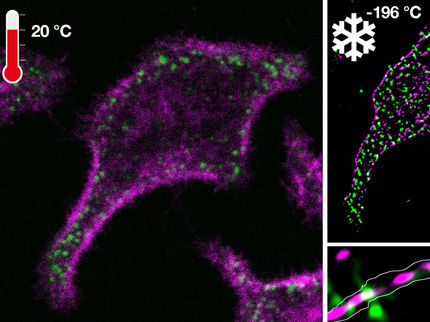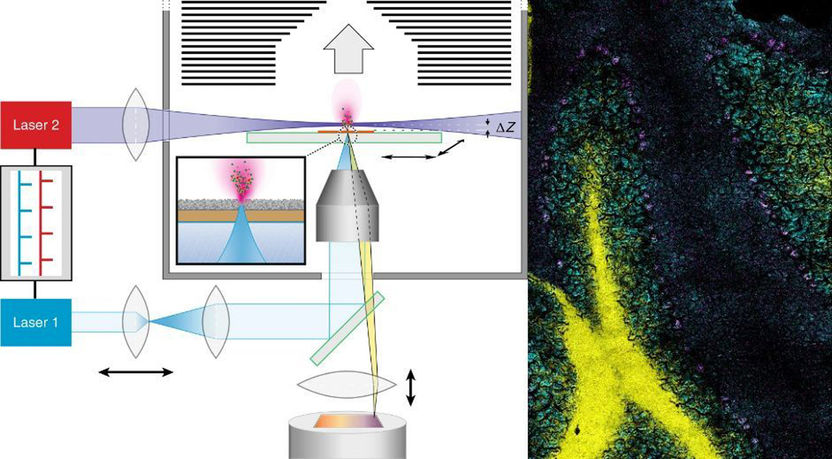AI-driven breakthroughs in cells study: advancements in super-resolution microscopy
By integrating AI with super-resolution microscopy, cellular biology is advancing in new and exciting ways
In 2014, the Nobel Prize in Chemistry celebrated the breakthroughs in super-resolution microscopy, a technology that allows us to capture highly detailed images of small parts of cells using fluorescent microscopy. Despite its success, the resolution of super-resolution microscopy still can’t show tiny distances between organelles in cells. This gap is where artificial intelligence (AI) and Biomedical Computer Vision intersect, as researchers from SFU Computing Science and UBC School of Biomedical Engineering and Life Sciences Institute reveal how AI enhances super-resolution microscopy capabilities and contributes to cellular biology advancements. Their mission is clear: to overcome the limitations of hardware (super-resolution microscopy) through innovative algorithms (AI).
Their latest work, published in the Journal of Cell Biology, introduces a scalable reconstruction algorithm called MCS-DETECT. This novel algorithm is like a digital detective, detecting membrane contact sites (MCS) in large microscopy volumes without the need for segmentation. This groundbreaking research showcases how AI software can enhance the capabilities of super-resolution microscopy.
We interviewed the researchers to explore the complexities of super-resolution microscopy, the development of intelligent algorithms, and the real-world implications of their work.
Interdisciplinary Approach to Cellular Biology and Disease Research
The collaboration between Ben Cardoen, Ghassan Hamarneh, Kurt Vandevoorde, Guang Gao, Milene Ortiz Silva, and Ivan Robert Nabi emphasizes the importance of understanding cell function in health and disease. The team uses super-resolution microscopy to capture images of small parts of cells and their interactions. The key innovation is in developing an algorithm that quantifies these interactions without the need for labor-intensive segmentation.
Unlike existing approaches, their algorithm can handle changes in intensity and adapts to different intensities in channels and cells. It avoids segmentation, which usually requires labor-intensive pixel annotation that is impractical at the microscopic level.
The significance of this research extends beyond the laboratory. It helps us understand cellular biology and the mechanisms underlying complex diseases such as neurodegenerative and metabolic disorders. The team's work may help find new cellular connections, paving the way for faster and more precise insights into affected cells, leading to improved understanding and targeted disease treatments.
Real-world Implications
The research findings extend into the real world, impacting drug discovery, cellular health, and our understanding of cells' responses to stress and infection. The tool, MCS-DETECT, developed by the researchers, can detect contacts that affect mitochondrial health and metabolism and are implicated in many diseases. The new research will help scientists analyze how genomic or pharmaceutical disruptions affect cellular health and gain insights.
The researchers have presented their findings and made their source code and tools available, promoting transparency and encouraging further exploration by the scientific community. The team is currently delving into the complex role of riboMERCs and applying their tool to live cells to explore dynamic interactions.
The research received a substantial grant, emphasizing the recognition of its potential from the project's start. This work has implications beyond academics. It can influence future research trajectories and open new doors for researchers.
New Discoveries
By integrating AI with super-resolution microscopy, cellular biology is advancing in new and exciting ways. This interdisciplinary approach not only pushes the boundaries of computer science applications but also holds the promise of unraveling the mysteries of cellular biology and contributing to the development of targeted treatments for devastating diseases. As the researchers continue to explore new avenues, we can anticipate more precise and groundbreaking insights into the invisible world within our cells.
Original publication
Ben Cardoen, Kurt R. Vandevoorde, Guang Gao, Milene Ortiz-Silva, Parsa Alan, William Liu, Ellie Tiliakou, A. Wayne Vogl, Ghassan Hamarneh, Ivan R. Nabi; "Membrane contact site detection (MCS-DETECT) reveals dual control of rough mitochondria–ER contacts"; Journal of Cell Biology, Volume 223, 2023-11-10
Most read news
Original publication
Ben Cardoen, Kurt R. Vandevoorde, Guang Gao, Milene Ortiz-Silva, Parsa Alan, William Liu, Ellie Tiliakou, A. Wayne Vogl, Ghassan Hamarneh, Ivan R. Nabi; "Membrane contact site detection (MCS-DETECT) reveals dual control of rough mitochondria–ER contacts"; Journal of Cell Biology, Volume 223, 2023-11-10
Topics
Organizations
Other news from the department science

Get the analytics and lab tech industry in your inbox
By submitting this form you agree that LUMITOS AG will send you the newsletter(s) selected above by email. Your data will not be passed on to third parties. Your data will be stored and processed in accordance with our data protection regulations. LUMITOS may contact you by email for the purpose of advertising or market and opinion surveys. You can revoke your consent at any time without giving reasons to LUMITOS AG, Ernst-Augustin-Str. 2, 12489 Berlin, Germany or by e-mail at revoke@lumitos.com with effect for the future. In addition, each email contains a link to unsubscribe from the corresponding newsletter.
More news from our other portals
See the theme worlds for related content
Topic world Fluorescence microscopy
Fluorescence microscopy has revolutionized life sciences, biotechnology and pharmaceuticals. With its ability to visualize specific molecules and structures in cells and tissues through fluorescent markers, it offers unique insights at the molecular and cellular level. With its high sensitivity and resolution, fluorescence microscopy facilitates the understanding of complex biological processes and drives innovation in therapy and diagnostics.

Topic world Fluorescence microscopy
Fluorescence microscopy has revolutionized life sciences, biotechnology and pharmaceuticals. With its ability to visualize specific molecules and structures in cells and tissues through fluorescent markers, it offers unique insights at the molecular and cellular level. With its high sensitivity and resolution, fluorescence microscopy facilitates the understanding of complex biological processes and drives innovation in therapy and diagnostics.
Topic World Cell Analysis
Cell analyse advanced method allows us to explore and understand cells in their many facets. From single cell analysis to flow cytometry and imaging technology, cell analysis provides us with valuable insights into the structure, function and interaction of cells. Whether in medicine, biological research or pharmacology, cell analysis is revolutionizing our understanding of disease, development and treatment options.

Topic World Cell Analysis
Cell analyse advanced method allows us to explore and understand cells in their many facets. From single cell analysis to flow cytometry and imaging technology, cell analysis provides us with valuable insights into the structure, function and interaction of cells. Whether in medicine, biological research or pharmacology, cell analysis is revolutionizing our understanding of disease, development and treatment options.
Topic world Digitalization in the laboratory
The topic world Digitalization in the lab presents innovations and trends from digital data systems (ELN, LIMS) to laboratory robots and networked devices (IoT) to AI and machine learning.

Topic world Digitalization in the laboratory
The topic world Digitalization in the lab presents innovations and trends from digital data systems (ELN, LIMS) to laboratory robots and networked devices (IoT) to AI and machine learning.




























































